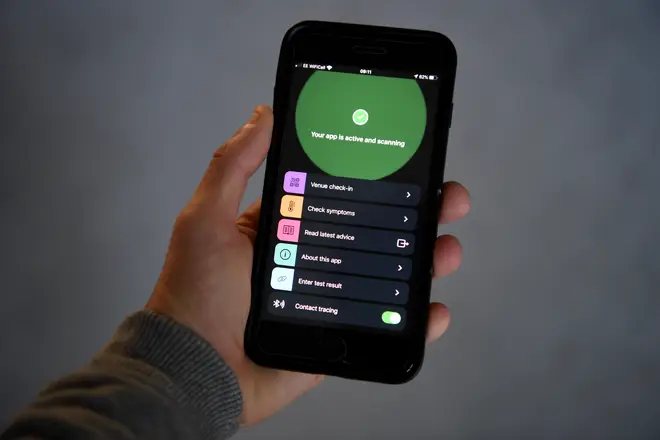
Nick Ferrari 7am - 10am
27 September 2020, 16:58 | Updated: 27 September 2020, 17:19

The NHS Covid-19 Test and Trace app was finally launched by the Government in England and Wales on Thursday. But how does it work, who developed it and what are the problems it is facing?
The coronavirus app was initially meant to be launched in mid-May as part of Boris Johnson's "world-beating" test and trace system.
However, following problems with the original app, which did not recognise most iPhones, a new app based on decentralised technology developed by Google and Apple has been launched in England and Wales.
The government has termed this weekend "The Big App Download Weekend", with adverts in newspapers, online and on social media, encouraging people to download the NHS Covid-19 app.
Scotland released its own app called Protect Scotland earlier this month, which was based on similar technology, while Northern Ireland released its app in July.
How does the NHS Covid-19 Test and Trace app work?
The app can be downloaded onto smartphones and uses Bluetooth technology to work out when other app users are close enough to be potentially spreading the coronavirus.
It is available on Apple’s App Store and Google’s Play Store by searching ‘NHS Covid-19’.
The app does not track users' locations but instead measures the strength of the Low Energy Bluetooth signal, which phones with the app installed emit.
The signal strength and length of time in proximity to other devices is used to work out the distance between users and calculate the risk of virus transmission.
The app keeps an anonymous log of others nearby who are also using the service, so if and when someone starts showing symptoms, or tests positive for Covid-19, they are able to share that on the app.
It then sends a notification warning of possible infection to all those phone users who have come into proximity recently.
The app works on both Apple and Android phones and only uses around two to three per cent of power per day, according to the developers.
Children do not need to use the app, which is targeted at those over the age of 16.
Read more: Culture Secretary admits 'teething problems' with failing NHS Test and Trace app
What other features does the NHS Covid-19 Test and Trace app have?
In addition to the Bluetooth proximity tracing feature, the NHS Covid-19 app also includes a built-in QR code scanner, which allows users to check in at hospitality venues through scanning a poster.
Users can also check symptoms, order a test and see the risk level in their area, all inside the app.
The government says future versions of the app may include additional features to help people keep track of the risk they are personally encountering day-to-day.
Are there privacy issues with the app?
The decentralised nature of the Apple and Google technology, which the NHS Covid-19 app is based on, means most privacy concerns should be assuaged.
Mr Emmerich, the CEO of the company that build the app, says that building it on the Google and Apple technology has “built in privacy by design”.
The government also says no personal information is collected, with no name or email needed to use the app.
All data that is given is held only on the user’s phone, where it can be deleted at any time.
The app does not use GPS to track users, so cannot track people’s location. However, users are asked to provide the first part of their postcode to show the risk level in the local area.
Who developed the coronavirus app?
The government says the app was designed and built by the NHS Test and Trace department in the Department for Health and Social Care.
Contracts were given to various companies, including Swiss company Zuhlke Engineering, which was awarded more than £5 million across two contracts for development and support on the much-delayed project.
The firm's chief executive, Wolfgang Emmerich, told the PA news agency that the app is "rock solid", but developers would continue to improve it over the next six months.
However, the exact details of the tender process for the app are unclear. Pressed on the details of the process by LBC’s Swarbrick on Sunday, Culture Secretary Oliver Dowden was unable to provide any details.
“This process has been run through the Department of Health, so I don’t want to give you or your listeners misleading information on this. I think it is best to ask those questions to the health secretary,” the secretary of state for digital, culture, media and sport said.
What are the problems with the new app?
There have been widespread reports of problems with the new NHS Covid-19 Test and Trace app, with Mr Dowden conceding to LBC that there were “teething problems”.
Officials admitted earlier this week that a system flaw meant app users with coronavirus tests processed at an NHS hospital or Public Health England (PHE) lab may not have been able to list their results.
This also includes tests undertaken as part of the Office for National Statistics' national surveillance programme.
But the Department of Health said on Sunday morning that the glitch had been fixed, although people who book a test through a third party still can't upload negative results.
The flaw was only reported to affect users in England, while Wales said it had already sorted the coded system on the app.
Read more: Utter incompetence: embarrassment as Covid app only part works – again
The app will also not work with some older phones. It requires iOS 13.5 on iPhones, which can be installed on phones from the 2015 iPhone 6s onwards.
On Android the app requires version 6.0 or higher, which was rolled out in 2015.